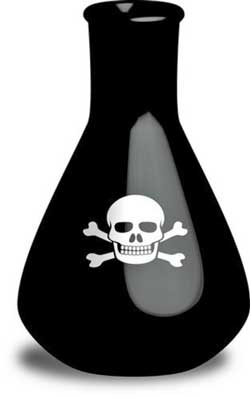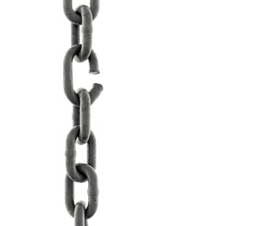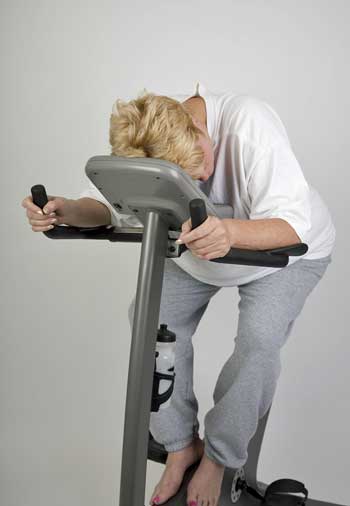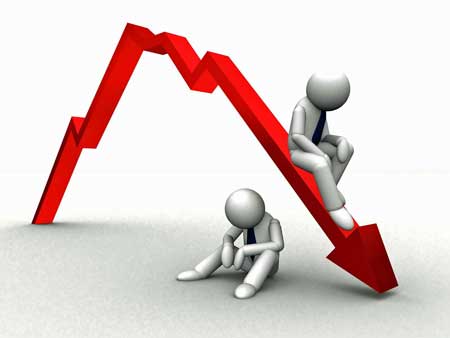



(See end for a short synopsis)
“Collectively, these data indicate that ME/CFS participants were unable to reproduce most physiological measures at both maximal and ventilatory threshold intensities during test 2, despite exercising to maximal effort during both tests” Keller
The Keller paper starts off proposing that if a bout of exercise makes you weaker rather than stronger, something is probably wrong with your ability to produce (aerobic) energy. That makes sense, and three studies have now demonstrated that in ME/CFS, but assessing one’s aerobic energy capacity is not a test one associates with an ME/CFS diagnosis – at least not yet.
Inability of myalgic encephalomyelitis/chronic fatigue syndrome patients to reproduce VO₂peak indicates functional impairment. Keller BA, Pryor JL, Giloteaux L. J Transl Med. 2014 Apr 23;12:104. doi: 10.1186/1479-5876-12-104.
This study – the fourth to suggest that metabolic issues are keeping people with Chronic Fatigue Syndrome from hitting the gym (or even the streets, sometimes) – simply validates what a critical area of research exercise is, and in the most exercise-challenged illness of them all.
The Study
In this study twenty-two people with Chronic Fatigue Syndrome (ME/CFS) underwent a two-exercise challenge: two exercise tests to exhaustion within 24 hours of each other. Keller examined multiple variables during the tests.
The VO2 max at peak effort of the ME/CFS patients was only 77% of expected normal in the first test, and things got worse from there.
Peaking Early: Across the Board Declines in Metabolic Functioning at Peak Effort
The broad declines in almost all the measures on the second test suggested that, yes, something went very wrong with the ME/CFS patients’ energy production system. The breadth of the declines was notable. Most successful research studies show some statistically significant abnormalities, but in this study virtually every measure of cardiovascular/metabolic functioning declined significantly and, in most cases, statistically very significantly on the second exercise test. That suggested the energy production system got whacked in just about every way possible.
The probability figures denote the probability that the results occurred by chance. A p< .05, the cutoff for a ‘significant’ or meaningful result, indicates a 5% probability that the result occurred by chance. That’s good enough for most researchers to call their study a success.
We know about the problems with VO2 max (14% decline, p<.001), but Keller’s study also showed that at peak exercise the ME/CFS patient’s peak heart rates declined by about 16% (p<.001), ventilation was down by 15% (p<.003), carbon dioxide output was down by 16% (p<.001), and cardiac output (oxygen delivery) dropped by 9% (p<.003).
The ME/CFS patients’ heart functioning, breathing, rate of CO2 removal, and the amount of oxygen delivery as well as their oxygen consumption (VO2 max) declined dramatically.
The same pattern prevailed when they reached the point of greatest lung workload, i.e., when their lungs were exchanging the most gas with the atmosphere. The peak oxygen consumption dropped by 16% (p<.003), their work output dropped by 22% (p<.03), their carbon dioxide output dropped by 11% (p<.014), their cardiac output (oxygen delivery) dropped by 13% (p<.003), and their ventilation dropped by 8% (p<.035). Their heart rates did not drop significantly.
Everyone Flunks
When she put aside the group data and looked at the 22 patients individually, she found that everyone tested flunked the VO2 max test in some way. Most patients had reduced VO2 max at peak exercise, but those who did not had reduced VO2 max at their ventilatory threshold.

Toxic by-products that gather in the muscles during anaerobic energy production in ME/CFS cause fatigue, pain and other symptoms
Our anaerobic energy production system gets engaged when we participate in short bursts of rapid exertion such as running up the stairs to get to a meeting. Toxic byproducts accumulate in the muscles and blood when this occurs, but a return to the slower-paced aerobic energy production system usually quickly removes them. The reduced aerobic energy production found in ME/CFS patients suggests they can’t engage in many normal activities without entering into anaerobic metabolism. A wimpy aerobic energy production system that is less effective at cleaning up the toxins results in increased recovery times.
Interestingly, Keller said ME/CFS patients who are able to successfully reproduce their VO2 max/VT levels on the second test often have problems with blood pressure/heart rate regulation; i.e., something else is wrong.
Next, Keller compared the past 2-day ME/CFS CPET (maximal exercise) studies. Note that what we have here is what three exercise physiology groups found in three different locations looking at three different sets of patients. This is what you want in medical research: validation by different laboratories looking at different patient groups. Let’s see what’s happened.
Comparing Studies or Will the Real Metabolic Dysfunction Please Stand Up?
The results of this study confirm previous work that demonstrated an abnormal
response to exercise in fatigued ME/CFS patients. Keller
Keller’s comparison of her results with the results from prior two day maximal (CPET) exercise studies revealed some similarities and some significant differences. The upshot is that people with ME/CFS appear to be pretty adept at flunking a second exercise test; they just sometimes do it in different ways.
V02 Max
The first study by Snell et al containing just six ME/CFS patients and six controls found a 22% drop in VO2 max. A second larger study from the same lab containing 61 participants did not find significant differences in VO2 max between the first and second exercise tests, but it did find significantly reduced work at ventilatory threshold. Using VO2, VT VO2 as well as peak workload and VT workload the Snell group was able to diagnose correctly 95% of the ME/CFS patients.
Vermoulen also did not find significant reductions in VO2 max in his first study. The 6.3% drop in VO2 max found in ME/CFS patients in the Vermoulen 30-person study (15 ME/CFS, 15 controls) was essentially inconsequential statistically since it was within range of normal test-retest variability. Keller noted, however, that Vermoulen did not thoroughly explain his testing parameters in that study.
With Keller’s finding of reduced VO2 max, we have two studies finding reduced VO2 max and two studies not finding it.
Ventilatory Threshold – the New VO2 Max?

Ventilatory threshold – which indicates the point at which the aerobic energy system wears out – may be a better measure for ME/CFS than VO2 max.
Ventilatory threshold indicates the point at which increased levels of CO2 and lactic acid cause your breathing rate to markedly increase. It’s a sign that anaerobic metabolism has come to dominate your energy production, and as such may be a better indicator for ME/CFS. Another way of thinking about this is to see ventilatory threshold as the point at which your ventilation or breathing has little impact on energy production because your aerobic system is tapped out, and you’re now running on anaerobic metabolism. VO2 max at ventilatory threshold is the point of maximum oxygen consumption during this time.
We were fixated on VO2 max at peak workload, but V02 max at ventilatory threshold may be the more common problem in ME/CFS. Keller, Van Ness, and Snell all found reduced VO2 max at ventilatory threshold on the second exercise test. With the fifteen percent or so decreases in VO2 max at ventilatory threshold, ME/CFS patients are far higher than the 1.5% changes in healthy controls or athletes.
The amount of work measured at ventilatory threshold was reduced in the Keller and Snell study, but not in the Vermoulen study.
The reduced ventilatory threshold during the second test indicates that something happening during the first exercise session impaired the ME/CFS patient’s ability to produce energy aerobically in the second test. That reduced aerobic production resulted in their entering into anaerobic metabolism much more quickly than normal. As Dr. Keller put it, exercise knocks people with ME/CFS into ‘premature anaerobiosis’.
Others
Keller’s and Snell’s study found significant decreases in work, and she found reductions in heart rate while Vermoulen found neither. Both Keller and Vermoulen (in his latest study) found evidence of reduced oxygen delivery. The other studies did not look for it.
Not Equipment Failure!
This drop in aerobic capacity from one exercise test to the other is so unusual that other researchers have assumed something must be wrong with the equipment, so Keller did something in her paper that I’ve never seen before: she took care of that elephant in the room by bluntly stating there was nothing the matter with her equipment, because repeat CPET tests during the same time period in healthy controls were normal.
A Unique Group of Patients
ME/CFS patients currently represent a unique class of ill patients who do not reproduce maximal CPET measures, unlike individuals with cardiovascular disease [27,30], lung disease [28], end-stage renal disease [26], pulmonary arterial hypertension [25], and cystic fibrosis [29]. Keller

ME/CFS is the only disorder thus far identified with this strange reduction in energy production after exercise.
Calling ME/CFS patients a ‘unique class of ill patients’ she outlined how unusual these findings are by noting that people with cardiovascular disease, lung disease, end-stage renal disease, pulmonary hypertension and cystic fibrosis can all do repeat exercise tests with no drop in aerobic capacity.
VO2 max at Peak Effort vs VO2 max at Ventilatory Threshold – Does it matter?
I asked both Staci Stevens of Workwell and Dr. Keller if the two measures are showing something very different. A reduced VO2 max shows an inability to generate normal amounts of energy. A reduced VO2 max at anaerobic threshold shows that ME/CFS patients enter into anaerobic energy production more quickly. (You can measure VO2 max at while resting, at peak workload, at AT…). Staci stated both measures show metabolic dysfunction, and that’s what’s important.
It was significant that Snell used four metabolic measures (VO2, VT VO2, peak workload and VT workload) to diagnose correctly 95% of the ME/CFS patients in their study correctly. The individual measures weren’t as important diagnostically as the fact that some type of metabolic dysfunction was present in the ME/CFS patients and was not present in the healthy controls.
Both exercise physiologists use anaerobic threshold to identify the heart rates ME/CFS patients should stay below in order to use their clean-burning aerobic energy system and avoid more pain and fatigue.
Dr. Keller suggested that biggerstudies could correlate specific metabolic abnormalities with different symptom clusters.
The Big (Big) Study
Both believe large-scale studies will be necessary to tease out the subsets present, search for biomarkers, and fully document the exercise challenges present in ME/CFS. We’re taking about a several hundred patient study costing from a half million to several million dollars. Both stressed these studies are completely doable; it’s just a matter of funding. Given studies of that scope Dr. Keller believes it’s quite possible they would find a biomarker that shows up during the first exercise test that would allow them to dump the second one.
When asked about the responses she’s had thus far to the study (which was published about a month ago) Dr. Keller said she’s gotten positive response from the ME/CFS community but has not heard from exercise physiologists who are not engaged in ME/CFS work. This didn’t surprise her.
“I’ve not heard from other exercise physiologists (other than Workwell), but that’s not unusual. Frankly, I don’t see others running to study ME/CFS until there’s an indication of funding availability for important studies and grant reviewers who are supportive of others to come into the field.”
Synopsis
- Dr. Keller finds across the board declines in almost all measures of energy production in ME/CFS patients in a second exercise test
- This suggests damage occurring as a result of the first exercise period inhibits energy production afterwards.
- This is a highly unusual – perhaps unique finding – that has not been found in other any disorders to date
- Dr. Keller’s comparison of the three other studies with similar findings suggests that metabolic dysfunction is common in ME/CFS but that variations may occur
- A large study able to definitively identify the subsets in ME/CFS and perhaps identify biomarkers that would allow only one exercise test to be done would probably cost from $500,000 to several million dollars.








How is it possible to even budget or seek funding for a large study when all they can say is “$500,000 to several million dollars”. This is so imprecise as to be virtually useless.
This was not a funding request and it was not intended to be precise – unless you’re looking to fund it in which case you should talk to Staci Stevens. I asked several people what they thought the cost would be and I got a range of answers and that was the range that was indicated.
Depending the size of the study (100 or 200 patients?), the scope – looking in the blood for biomarkers? or just doing the exercise test?- will determine how expensive the study will be.
A grant application for a study of this size to the NIH, of course, would include a precise figure based on the parameters of the study.
Well,and how does this get us closer to “the cause of the core issue in ME/CFS?”. I don’t remember reading anything about the cause anywhere.
Ok you have a point :). The cause is a broken aerobic energy system but it doesn’t tell us why that happens. I believe every successful exercise study that validates that problem, however, is ultimately getting us closer to the cause because it’s generating more interest in this key area and that will pay off over time. I grant that’s rather indirect 🙂
It’s sad to see that this still isn’t getting the attention it deserves. Here we have great research with positive findings that have been validated by different groups yet it isn’t getting any interest. I wish the media would get onto this.
On a positive note, there has been a small advance made here in Ottawa Canada. I have just completed another 2 day CPET protocol here at the Ottawa Heart Institute, a place that a few years ago knew absolutely nothing about this exercise problem with ME/CFS patients. Dr. Byron Hyde is trying to have the testing done here and managed to convince them to do a trial study. I was one of 3 patients of his that went down to Ithaca 2 years ago to undergo the 2 day testing by Dr. Keller. The testing procedure here followed Dr. Keller’s protocol and she is apparently coming here this week to go over the results and then take them home with her to analyze in depth. I was a “control” of sorts, my last results to be compared with these recent ones. I hope to get the results in a month or so.
I am so grateful to the work that Dr. Keller is doing and hope that she can get funding to do a larger study.
I so agree with Claire that I don’t understand why these studies which clearly show a major problem with our energy systems are ignored by other researchers and the media. Here in the UK we desperately need to raise awareness of this huge energy deficit problem ME/CFS sufferers have.
Is there anyway that somebody like Dr Keller could contact an organisation like the BBC to let them know of her findings. The BBC quite often mention on News items how the illness is often regarded as psychological whereas if the Science editors were informed of studies like this they might well take some interest and realise they need to change their opinions.
Pam
That’s very positive Claire! Check this out: first we had a small group at a small University in California doing these tests, then a lone exercise physiologist in France did, then Dr. Keller – an academic at Ithaca College did – now hopefully a Heart Institute is. I have no idea how bit the Ottawa Institute is but we’re clearly moving up. These small steps will pay off!
Thanks
It would be amazing if we had a 2 day test to diagnose ME.
The problem with this 2 day test protocol is that it causes severe PEM. There is debate amongst the doctors about whether they should be putting the patients through this. I am currently in a bad state having just gone through the 2 day test protocol last week. I am worried ( actually quite scared) about how much damage I have done to my body this time and how long this crash will last. Thoughts about being permanently bedridden are percolating through my head as I lie here and I am freaking out a bit.
I hope that by doing this type of research along with cytokine measurements and other metabolite testing before, during and after the 2 day test protocols there will eventually be a marker that will be measurable in the blood after just one CPET test that will be able to distinguish the ME/CFS patients from the rest. Or better yet, a marker that will show up after no exercise!
For many patients, even a one-day test protocol causes severe PEM. Many years ago, I took a treadmill test to ensure a “treatable” heart condition was not responsible for my chest pains and palpitations. ME patients often cannot achieve their age-predicted heart, and this was the situation for me — at least at that time. After 11 minutes of maximal effort, my HR was still extremely low. The cardiologist’s interpretation was: “It appears you are an elite athlete with a strenuous exercise program. My advice . . . keep doing what you are doing — it is obviously working.” By that evening, I had to support my arms in my lap while driving to pick my husband up at work. By the following day, I had to rest three times while brushing my teeth. It took several days to recover.
Now, 20 years later, I have the opposite heart rate problem. With severe POTS, my HR goes into the mid 150’s brushing my teeth.
I can certainly understand your “freaking out”, Claire — I would be too, and more than “a bit”. Best wishes for a rapid return to your pre-test condition.
Karen,
So what is the conclusion on your chest pains? Only POTS? Not sure?
Thanks,
Jim
Good luck Claire! That’s no fun. Rest and relax and try and let those scary thoughts go….
Dr. Keller is with you on this. My guess is that the more they examine exercise the quicker they’ll be able to determine when we exercise what goes wrong. A study at the IACFS/ME found cytokine abnormalities, Dr. Klimas is looking at gene expression – a Canadian groups wants to look at gene expression as well- and the CDC is looking at gene expression after one test as well.
Whatever happens to the body happens during the first test – so ultimately there should be no need for two tests and it could be, as you say there will be need for no test – if the biomarker is present without exercise- or if the biomarker they find helps them find another biomarker…
I hope you feel better soon. Have you tried saline IV’s? Those can be really helpful at snapping patients out of exertion caused relapses
Saline IV sounds like an excellent idea. I don’t have a naturopath at the moment but I should get one ASAP. I don’t think I mentioned in my replies above but 2 days after doing the testing last week I got really sick with a gastrointestinal bug ( or food poisoning?) and got really dehydrated. I am still feeling really bad, can hardly eat, and am probably still very dehydrated. I have low blood pressure and orthostatic hypotension at the best of times so right now it is probably really bad. Thanks ,Cort ,for the advice.
This is an important and encouraging study. My concern is that, if this becomes the required biomarker to confirm one has ME, what is someone who is completely bedridden to do? Those with severe ME could not have this test done.
I think Claire has a good point. The Lights did a gene expression study using a single MODERATE exercise. That was a small study but they had NIH funding for a large replication that was apparently positive, though has yet to be published. A single, moderate exercise test would be more appropriate for people with ME.
You couldn’t pay me enough money to take even one max test. My last relapse, which took me nearly 2 years to get over, happened after way less than maximal exertion – a 2-day test is not for everyone. At he IACFS conference, one researcher involved in testing said “patients should expect a relapse”.
Hello Simon. 7 months ago I took a 2-day CPET test and it has been devastating to my health. I am now housebound and not far off bed-bound and suffering from body-wide inflammation. I have never been anything like this bad in all of my 35 years with CFS. The sledgehammer hit me the day after the second CPET and I haven’t noticed any improvement since. I am happy to see you have recovered from your tests even though it took 2 years; it gives me some hope.
If memory serves, didn’t Dr. Klimas start an exercise study in March of 2013 that was to look for biomarkers on a real-time basis, i.e. when the participants were in the act of a controlled exercise? Is there a progress report available on this?
Thanks for the details on this study, Cort. Always great to have further validation that something is truly dysfunctional in our systems. But I sure look forward to studies trying to make a cause and effect connection.
She reportedly found that exercise appears to hit the autonomic nervous system which then triggers an immune cascade which causes the postexertional relapse- but nothing has been published yet so far as I know.
I try to donate to everything I can that I think could make a difference to ME and lots of other people in the ME community are doing the same (its great to actually have projects going on that we can help to fund) unlike the recent past when nothing was happening at all and no hope of change whats so ever.
I would love to help crowd fund a big two day exercise test and I’m sure lots of other people would too. I know as Claire has said it is an issue for ME patients that they have to take an enourmous risk to take part in these tests. But I still think that many would want to do it if they thought it could help change the perception of ME once and for all and convince the medical world about the true nature of this illness. In my younger days I would have been willing myself.
That may be how this gets done. Obviously if it happens it needs to be done carefully and with less ill patients. I would think IV saline should be given to everybody after the second test.
Some of us were genetically never meant to be endurance performers. I developed ME/CFS, while doing strenuous (aerobic) exercise. I just kept pushing myself beyond my (genetically, inborn) mitochondrial limit, even though I knew, that my body was telling me to stop.
Even as a child, I never had the endurance it took to be a long distance runner (aerobic).. I enjoyed track and field events, but the activities I excelled at were the ones that required short bursts of energy (anaerobic), the 100 yard dash, standing long jump, or running long jump. I always won the red ribbons in these events. But, as much as I tried I never had the stamina to run long distance. I was always curious, as to why?
I’ve come to understand that slow-twitch muscle fibers like those of the long-distance runner have abundant mitochondria and use large amounts of energy slowly so that you can work out for a long time without getting tired. Slow fibers use oxygen-using (aerobic) pathways for activities that require endurance.
Fast-twitch muscle fibers found in sprinters have less mitochondria and use small amounts of energy quickly. Fast fibers use sugars for fuel (anaerobic) and do not require oxygen. It gives you the ability to run fast, but for short distances. The byproduct of this (anaerobic) energy production is heat and lactic acid. Lactic acid accumulation in the muscle causes fatigue and soreness. The (anaerobic energy) system is a limited system for energy production.
The organization of muscle fibers in each or us is determined by our genes. I now understand, that the endurance of the long-distance runner (aerobic) and the short-burst of energy experienced by the sprinter (anaerobic) are both genetic in nature. If I had known this almost thirty years ago, I may have been able to save myself from developing ME/CFS. I would not have tried so hard to be something I was not genetically born to be; an endurance athlete.
Rachael,
Certainly, you know your body best. But, based on my experience, knowing your genetic nature much earlier may not have saved you from developing ME/CFS. Being an endurance athlete for many years prior to my sudden onset didn’t save me.
What I was trying to point out is that there are some real genetically based differences in people that often seem to be overlooked, especially when it comes to exercise. “Some” of us cannot perform at the same aerobic level as others (never could) because of inborn, inherent, genetic, mitochondrial differences. Unfortunately, this doesn’t seem to be resonate with many researchers doing these studies. They don’t seem to take into account that there may be actual biological differences that contribute to this lack of endurance in “some” ME/CFS sufferers, which consequently contributes to post-exertional malaise.. While you don’t feel you fall into this category, (felt you were a born endurance athlete) I’m sure others with ME/CFS can relate to what I have written.
I exercise every day for about an hour and twenty minutes. I do that because I’m afraid that if I stop it will be much harder to start again, or to withstand stresses. My body has adjusted to the routine, but the CFS/ME slams me anyway, especially in the afternoon, and about once a week I get a killer headache. The only time I feel better is when I’m coming down with something, as my immune system is goosed.
By the way, I’m still waiting for news about Dr. Pridgeon’s anti-viral treatment experiments.
The Enteric Nervous System in the gut is part of the Central Nervous System that is also part of the Autonomic Nervous System then the Immune System etc.
Many Naturalpathic Medical doctors claim to eliminate CFS by cleaning up the digestive system
(no easy task)! RP
I showed this study to a Swedish researcher (who is positive towards ME/CFS research) and he was disappointed that there was no control group. Do you know why?
I still can’t get over that CDC is not including the 2 day bike test in their multisite study. That kind of large study is just what this field would need.
It was a GOLDEN opportunity …
Of course you always want a control group. There’s probably no control group because she’s doing this on her own with no funding….
This is a bit different situation, however. The finding itself is very unusual. It’s not a matter of degree. As she noted a drop in energy production in the second study – has never been seen before even in major diseases. If that’s not showing up in major disorders – what are the chances it’s going to show up in healthy controls? (probably zero).
Yes, odd that there was no formal control group. Chris Snell he had a control group in his study (just 5 people, I think), precisely to demonstrate the equipment was working properly.
I would like to personally thank Claire for having the courage to participate in a study which would result in a multi-day ME crash. Many patients will have to put their already compromised health in jeopardy, in order to build momentum towards new medical discoveries. Anyone who has experienced the grueling agony as a result of even mildest exertion from ME, must have the greatest empathy for Claire, as well as others who are willing to sacrifice for each of us in this community.
I, for one, am grateful.
Thanks..
How is ME/CFS different than adult onset Mitochondrial Disease?
Great question. An poster at the IACFS/ME conference suggested they might be very similar. The Chronic Fatigue Initiative is beginning to look at the mitochondria. It should be interesting.
Very interesting article, Cort – thank you. Time for me to stop putting off reading the full paper as it’s clearly an important one.